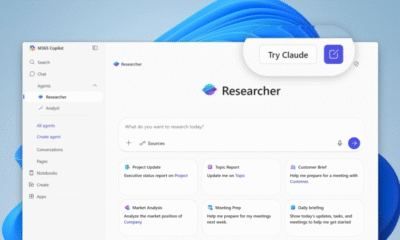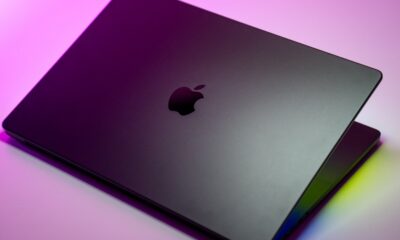Mobile Tech
Exploring the Enhanced Features of Apple’s Latest iPad Pro

This week, Apple unveiled a new M5-powered iPad Pro, once again making its tablet first in line for its latest generation silicon. This time, the flagship iPad shared the M5 spotlight with a new base-model MacBook Pro and a refreshed Vision Pro. However, it’s the iPad that’s undergoing the biggest changes.
To be clear, all three devices were modest refreshes that centered almost entirely around the new M5 chip. However, while the MacBook Pro gained a 4 TB storage option and faster SSD throughput, and the Vision Pro added a new headband, those two devices remain essentially the same as their predecessors.
That’s not to understate the significance of the M5 chip — especially for the Vision Pro, which skips ahead three generations of Apple silicon — but anyone hoping for a more substantial upgrade to Apple’s laptop or headset will have to wait until at least next fall.
The good news is that the iPad Pro has a slightly different story to tell. While one can argue that an M5 upgrade isn’t nearly as critical in Apple’s tablet — even with what iPadOS 26 now offers — Apple has still packed in a few extra enhancements that sweeten the upgrade.
Embracing the Wi-Fi 7 Era
Perhaps the most significant of these is that the M5 iPad Pro is now the first Apple device to expand Wi-Fi 7 support beyond the iPhone.
The iPhone has generally led the way into new Wi-Fi standards. The iPhone 11 was the first to adopt Wi-Fi 6. Wi-Fi 6E debuted on the M2 iPad Pro in late 2022 — a year before it came to the iPhone 15 Pro — but that also wasn’t fully a new standard.
Wi-Fi 6E — which only adds a 6 GHz band to Wi-Fi 6 — was particularly short-lived in the iPhone world, as the iPhone 16 jumped to Wi-Fi 7. Now, the iPad Pro is following suit — and it’s beating the Mac to the punch.
That’s courtesy of Apple’s new N1, an in-house chip that it designed to replace the Broadcom wireless chips that its devices have relied on for years. Naturally, if Apple is building its own chip, it’s going to ensure it supports all the modern standards. That means Wi-Fi 7, and also Bluetooth 6.0 — another significant upgrade for the iPad Pro.
In addition to those new wireless standards, the N1 chip also delivers a smoother and more reliable experience with features like Personal Hotspot and AirDrop — an advantage of Apple being able to tailor the design to optimize its own features.
The N1 chip was introduced in Apple’s 2025 iPhone lineup — the three new iPhone 17 models and the iPhone Air — but by all reports, it’s Apple’s plan to eventually bring this chip — or its successors — to every one of its devices. If anything, it’s a bigger mystery why Apple didn’t add its N1 chip into the M5 MacBook Pro or the Vision Pro (which still only supports Wi-Fi 6 — not 6E). However, Apple also still has the M5 Pro and M5 Max models to reveal — likely early next year — which could get the N1 or maybe even a more powerful “N1X.”
Boosting the Cellular Model
That would be similar to what Apple did with its 5G modem chips. While the N1 Wi-Fi/Bluetooth chip kind of came out of the blue (no pun intended), we’ve known about Apple’s work on a modem chip since at least 2019. It even acquired the ashes of Intel’s 5G modem business to help bring its modem designs in-house and reduce its reliance on Qualcomm.
That finally came to fruition earlier this year, when Apple unveiled the iPhone 16e with a new C1 modem chip. While Apple didn’t say much about raw 5G performance in the new chip, it proved to be a serious contender against Qualcomm silicon. However, the real gains were in power efficiency, and Apple followed this up last month with the C1X, a more efficient evolution of the C1 that was key to creating the incredibly svelte iPhone Air.
For various reasons, Apple stuck with Qualcomm chips in the iPhone 17 family, but it’s brought the C1X to the M5 iPad Pro. Apple says this delivers up to 50 percent faster cellular data performance, making the new iPad Pro an even better option for power users on the go. The chip also promises a 30 percent boost in power efficiency that should translate to better battery life, although Apple hasn’t commented on that, and the new model has the same 9–10-hour specs as its predecessor.
A Better Laptop Replacement
A few other subtle improvements make the M5 iPad Pro worth a serious look for power users.
For one, the two lower storage configurations now offer 12 GB of RAM — a 50 percent increase over the M4 model that should provide more headroom for the new windowed multitasking features in iPadOS 26. Combine that with the faster unified memory bandwidth (153 GB/s vs 120 GB/s), and apps and workflows should feel noticeably snappier.
While the 1 TB and 2 TB models have the same 16 GB as before, this RAM bump on the lower end means you won’t need to splurge for the more expensive models just to get a usable amount of memory.
Another significant change for pro users and gamers alike is the ability to drive an external display at higher refresh rates of up to 120 Hz. The new model also supports Adaptive Sync when used with a 120 Hz display, resulting in smoother, lower-latency motion during gaming or tasks like complex video editing and 3D rendering projects.
Rounding out the upgrades, the M5 iPad Pro is also the first Apple tablet to officially support fast charging. Plug it into a 60W adapter, and you’ll be able to bring it up from dead to 50 percent in about 35 minutes, making it ideal for road warriors.
-

 Facebook3 days ago
Facebook3 days agoWarning: Facebook Creators Face Monetization Loss for Stealing and Reposting Videos
-

 Facebook4 days ago
Facebook4 days agoInstaDub: Meta’s AI Translation Tool for Instagram Videos
-

 Facebook3 days ago
Facebook3 days agoFacebook Compliance: ICE-tracking Page Removed After US Government Intervention
-

 Video Games4 days ago
Video Games4 days agoGoku Takes on the Dragon Ball FighterZ Arena
-

 Video Games5 days ago
Video Games5 days agoTekken 8: Rise of the Shadows
-

 Amazon5 days ago
Amazon5 days agoNeil Young Takes a Stand: Pulling Music from Amazon in Protest of Jeff Bezos’ Support for Trump
-

 Microsoft3 days ago
Microsoft3 days agoMicrosoft Integrates Anthropic’s Claude AI Models into 365 Copilot: A Deepening Relationship with OpenAI
-

 Cars3 days ago
Cars3 days agoRevving into the Future: Ferrari’s Plan to Unleash 20 New Models, Including Electric Vehicles, by 2030




























